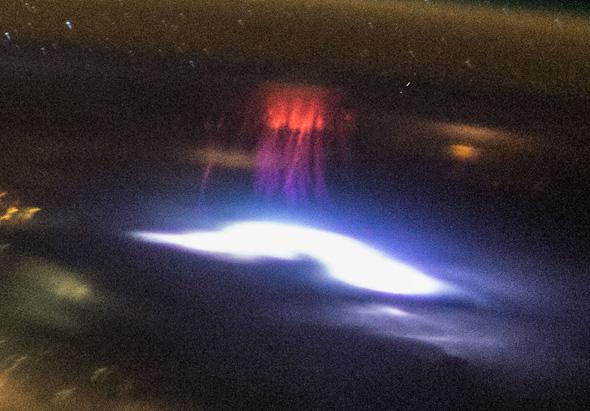You’d think that by now, deep into the 21st century, we’d have a pretty good handle on how something as common as lightning works.
But in fact there are still lots of mysteries to these gigantic bolts of electrical current, and a lot of their behavior is either unknown to or misunderstood by the public.
For example, have you ever heard of sprites? These are extremely fast and faint discharges that occur above thunderstorms. Way above, actually, from 50–90 kilometers up in the atmosphere. Most thunderstorm-producing clouds only reach a dozen or so kilometers in height, but clearly their reach extends much higher.
Sprites are beautiful and fleeting, and extremely difficult to photograph. Well, until recently, when more sensitive digital cameras became commonplace. One thing that makes it tough is that the sprites occur so high up you only really spot them above storms on the horizon; if you’re closer, the cloud itself blocks them (the fantastic photographer Randy Halverson caught a sprite in a storm photo that I wrote about a while back).
… Unless you have a better vantage point, like, say, above the clouds. Way above, as in space. Then you can get fantastic shots like this:

Photo by NASA
That was taken from the International Space Station on Aug. 10, when the orbiting lab was over the west coast of Mexico. Facing east, looking out toward the Yucatán Peninsula, there were several thunderstorms in view, and the one on the right, very near the Earth’s limb, produced a sprite. See it? The picture at the top of this article is a close-up.
How bizarre is that? It has the classic jellyfish-shaped top with dangling tentacles, and is probably a few dozen kilometers across, though it’s hard to tell exactly.
So what causes these? I had to do some digging, but came upon this informative (though technical) paper describing them. Big convective cloud systems can generate huge electrical potentials—separation of charges—and when it gets big enough you get a discharge of lightning to restore the charge balance.
This electric field can extend upward above the cloud, to the height of the mesosphere (and into the lower ionosphere) at nearly 100 kilometers. In general, it’s too small to generate any kind of discharge, and in fact, the majority of lightning storms don’t make sprites.
What the authors of this paper found is that certain atmospheric conditions really help. Rising air in a thunderstorm can make gravity waves, ripples in the air that move up and down. This causes the air density to increase, and that can be just enough to give the right conditions to make sprites. The air is ionized, the charges separate, and then you get a discharge similar to normal lightning creating the sprite.
The details are far more complex than this, of course, with the tendrils flashing and combing to create the other effects. One thing I think is neat: The red is from nitrogen molecules and oxygen atoms in the upper atmosphere, the same reason the aurorae sometimes glow red.
If you’re curious, the bright object in the sky is the waning crescent Moon, highly overexposed, and you can see Orion rising to the right. The exposure time was 1.3 seconds, and it looks like the camera got bumped a bit during the exposure; the stars make wiggly shapes. The greenish glow above the limb of the Earth is airglow, caused by the slow discharge of sunlight energy stored up by atmospheric molecules during the day.
In related news, and in a happy coincidence of timing, I was contacted by Steve Cullen, a software executive and someone who loves astronomy, about this very topic. He heard that Hurricane Hilda had quite a bit of lightning off the coast of Hawaii recently, so he checked the Canada France Hawaii Telescope’s CloudCam images—sure enough, he found some very interesting upper atmospheric lightning!
In that footage you can see the red flashes. To my inexperienced eye they look a lot like sprites, but Cullen tells me they are actually “Gigantic Jets,” a similar but different phenomenon. For one thing, sprites are associated with lightning, but jets aren’t always. Sprites can be higher in the atmosphere as well.
In another coincidence, Cullen works with astrophotographer Rogelio Andreo Bernal; I just posted photos and video Bernal took of the Perseids! Incidentally, Cullen and Bernal are both behind Starscape Gallery, an astrophotography gallery on the Big Island of Hawaii. Bernal is one of my favorite astrophotographers. I may have to pay the gallery a visit someday.
Tip o’ the blue jet to Stuart Rankin. P.S. Due to a cancellation, there are still four slots left for the Science Getaway to Hawaii Sept. 14–20! It’ll be a fantastic adventure.
